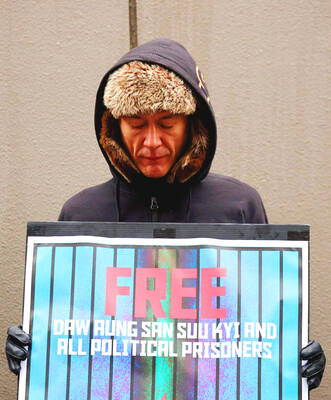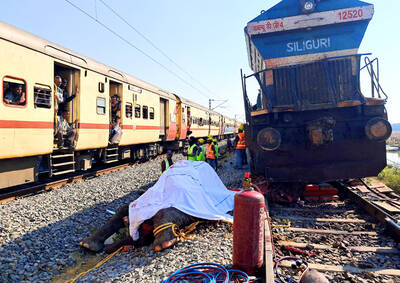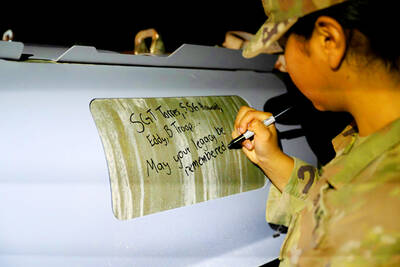Three Chinese ships yesterday patrolled the James Shoal (Zengmu Shoal, 曾母暗沙), an area that is also claimed by Taiwan and Malaysia, as soldiers and officers on board swore to safeguard China’s sovereignty over the disputed island in the latest sign of Beijing’s territorial assertiveness in the South China Sea.
The group was made up of an amphibious landing craft, the Changbaishan, and two destroyers, Xinhua news agency said.
“During the ceremony held in the Zengmu Reef area, soldiers and officers aboard swore an oath of determination to safeguard the country’s sovereignty and maritime interests,” Xinhua said.
The news agency said that fleet commander Jiang Weilie “urged soldiers and officers to always be prepared to fight, improve combat capabilities and lead the forces to help build the country into a maritime power.”
China is in an increasingly angry dispute with its neighbors over claims to parts of the potentially oil and gas-rich South China Sea. China lays claim to almost the whole of the sea, which is criss-crossed by crucial shipping lanes.
Beijing regards the shoal as the southernmost part of its territory.
In March last year, Malaysia protested against the incursion of four Chinese ships into waters around the shoal, about 80km off Sarawak on Borneo Island. Chinese sailors fired guns in the air during the visit.
In April, a Chinese maritime surveillance ship returned to the shoal to leave behind steel markers to assert Beijing’s claim.
China upset the Philippines and the US this month when it enacted rules demanding fishing boats seek permission to enter waters under the jurisdiction of China’s southern Hainan Province, an area the provincial government says covers much of the South China Sea.
Taiwan, China, Japan, Vietnam, Brunei, Malaysia and the Philippines are also embroiled in territorial spats over other parts of the South China Sea, as well as islands in the East China Sea.

The Burmese junta has said that detained former leader Aung San Suu Kyi is “in good health,” a day after her son said he has received little information about the 80-year-old’s condition and fears she could die without him knowing. In an interview in Tokyo earlier this week, Kim Aris said he had not heard from his mother in years and believes she is being held incommunicado in the capital, Naypyidaw. Aung San Suu Kyi, a Nobel Peace Prize laureate, was detained after a 2021 military coup that ousted her elected civilian government and sparked a civil war. She is serving a

Seven wild Asiatic elephants were killed and a calf was injured when a high-speed passenger train collided with a herd crossing the tracks in India’s northeastern state of Assam early yesterday, local authorities said. The train driver spotted the herd of about 100 elephants and used the emergency brakes, but the train still hit some of the animals, Indian Railways spokesman Kapinjal Kishore Sharma told reporters. Five train coaches and the engine derailed following the impact, but there were no human casualties, Sharma said. Veterinarians carried out autopsies on the dead elephants, which were to be buried later in the day. The accident site

‘NO AMNESTY’: Tens of thousands of people joined the rally against a bill that would slash the former president’s prison term; President Lula has said he would veto the bill Tens of thousands of Brazilians on Sunday demonstrated against a bill that advanced in Congress this week that would reduce the time former president Jair Bolsonaro spends behind bars following his sentence of more than 27 years for attempting a coup. Protests took place in the capital, Brasilia, and in other major cities across the nation, including Sao Paulo, Florianopolis, Salvador and Recife. On Copacabana’s boardwalk in Rio de Janeiro, crowds composed of left-wing voters chanted “No amnesty” and “Out with Hugo Motta,” a reference to the speaker of the lower house, which approved the bill on Wednesday last week. It is

REVENGE: Trump said he had the support of the Syrian government for the strikes, which took place in response to an Islamic State attack on US soldiers last week The US launched large-scale airstrikes on more than 70 targets across Syria, the Pentagon said on Friday, fulfilling US President Donald Trump’s vow to strike back after the killing of two US soldiers. “This is not the beginning of a war — it is a declaration of vengeance,” US Secretary of Defense Pete Hegseth wrote on social media. “Today, we hunted and we killed our enemies. Lots of them. And we will continue.” The US Central Command said that fighter jets, attack helicopters and artillery targeted ISIS infrastructure and weapon sites. “All terrorists who are evil enough to attack Americans are hereby warned